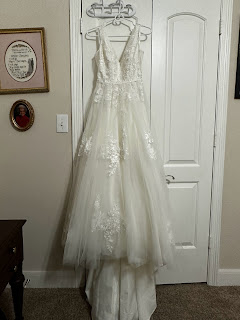The Dress
A wedding dress is an intimate, personal thing for many women and moves through several stages, from conception of the design of the dress, to the manufacture, wearing it and placing it on the hangar after the glorious day. Imagining the hands that have touched it, the eyes that have seen it, and how it has moved through the day of the wedding can be a multi level experience.
I am writing this because I recently submerged my daughter’s wedding dress into a bathtub of warm, soapy water after she had worn it just three weeks before. The thought of putting water on this gorgeous gown, so beautifully worn, with its six layers of satin, lace, netting, and sparkling hand sewn sequins and beads was terrifying. What if it discolors? What if it shrinks? What if the stains from wine, and being dragged along the grassy wedding site and boisterous dance floor don't come out?
To think about the progression of its inanimate “life” we must start at the beginning. As a seamstress myself, I would start at the design, the pattern, and the selection of materials to make the wedding dress. Many patterns begin with a similar bodice, sleeve (or no sleeve) and skirt. The options are endless - fitted or full bodice, full or slim skirt, petticoat or none. Then the fabric, the adornments, length, and it goes on. What I'm trying to say is that it is a creation that unless bought off the rack, is typically made to order for a bride.
If you have ever been to a bridal store, you’ve seen dozens of wedding dresses sitting prettily in the window and on glamorous manikins. And then, racks and racks of dresses are available to try on. The sales associate zips in the bride-to-be, and clips it in place for the thin, medium, or large sized woman. When satisfied with the look, the dress is ordered and the bride waits 3-9 months for her dress. Once the dress comes in, it must be tried on at the store again and fitted and altered (for the price of another dress, in many cases).
The time and effort that goes into selecting a dress is a huge ordeal, and thus, the fear of mine to immerse the lovely creation into water. There is a good ending to this story, washing the wedding dress was a success!
Here's how I washed my daughter's wedding dress:
- Clean the wedding dress within a few weeks after the event, as soon as possible.
- Remove grass, burrs, confetti, and any other items that may have become stuck to the netting.
- Use a delicate fabric detergent
- Pre-treat wine and other stains with detergent and let sit 5-10 minutes beforehand.
- Lay several towels along the bathroom counter, if long enough, and if not, a long table or a hard floor.
- Fill up the bathtub with water at the temperature you would bathe a baby - When you insert your elbow, it is not warm.
- Gently lay the dress in the water and flatten it under water, then "massage" it a little.
- Take a clean toothbrush, and putting a little detergent on the toothbrush, scrub the stained areas.
- Then, let it sit 20 minutes or so.
- "Massage" it again, concentrating on the stained areas, and let it sit another 5-10 minutes.
- Drain the bathtub, and when almost drained, take a cup or a bowl and pour water on it, starting at the top, and moving towards the bottom, for a quick rinse.
- Add water the bathtub again, massage it, and let it sit another 5 minutes.
- Drain and rinse in the same manner as above.
- Pull the dress out of the water and squeeze it and shake it a little, then transfer it to the bathroom counter.
- Place towels on top of the dress to dry it from the top, then throw in the dryer to use later.
- After several hours, lift the dress and place new towels on the counter, and turn over the dress to dry on the other side.
- When almost dry, hang up your clean wedding dress, and when completely dry, put it in a dress bag, hoping it will be worn by another bride, or passed down a generation.




